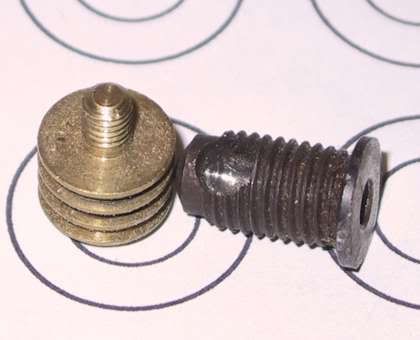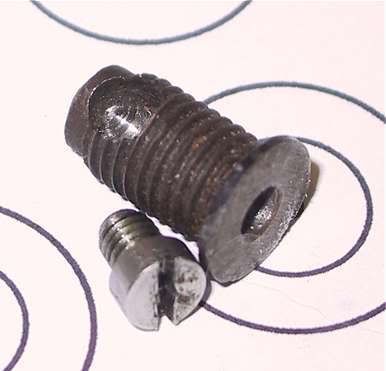Good Morning Bluejacket,
Venting is usually done to try to solve an ignition job.
Theorically, the back pressure created from the ignition of the main powder charge is supposed to blow out residue build-up in the flash hole between the bottom of the nipple and the powder charge.
The back pressure IS SUPPOSED to lift the hammer slightly and vent through the nipple. Well.... depending on the caliber and powder charge, maybe it does..... or maybe not.
Some rifles seem to suffer more from this build-up of residue than others. If you have a rifle that is having an ignition problem, venting might or might not solve the problem.
Should you wish to vent your drum, it is best to drill the end of the breech. In this way, the full length of the drum will be cleared by the back pressure of the ignited powder charge.
Of course, there is a disadvantage to any shooter standing to to the vent side of the drum; getting splattered by vented gasses. You really should warn them of that possiblity; unless, of course, you have a reason for splattering somebody (that is a joke;..... I think).
In a number of cases, the flash hole diameter inside the drum, between the end of the nipple and the powder charge is much too small and cause fouling residue to build up very quickly.
If SAFETY POSSIBLE, sometimes this part of the drum can be drilled out to a larger diameter. BUT, DO NOT, drill past or through the diameter threaded for the nipple.
The better designed drums have a larger diameter flash hole than the diameter where the nipple hole is threaded.
Should you decide to vent your drum, be aware that eventually the vent hole wil be eroded to a larger diameter, which can introduce another problem in terms of accuracy.
It is for this reason, my personel perference is to istall a vented clean-out screw in the end of the drum. When the clean-out screw is eroded out beyond use, it can be replaced without the need to replace a vented drum.
Patten breech nipples seem to have more than their share of this problem also.
When Rabbett03 built his TOTW Jim Bridger Hawken, he was overwhelmed with fouling and complete blockage of the flash hole in less than 5-6 shots.
We solved the major problem, but still had to vent the snail to get reliable and consistent ignition. There is still one more correction that can be done, but requires removing the breech from the barrel.
Since Toney's problem, I have been studying modern patten breeches of all makes and have come to a definate personal opinion about a certain aspect of todays patten breech design.
Many of the breeches have a shallow or short depth poder chamber with the flash hole drilled at an angle straight to the bottom of the nipple.
This is supposed to promote faster ignition.
When one measues the length of the flash hole from the end of the powder chamber to the bottom of the nipple, it become readily apparent this is a very long distance for the primer flash to travel up a small diameter hole to the powder charge.
Depending on the make of the breech plug, the flash hole length varies from 3/4" - 1". No wonder fouling builds up and blocks the flash hole.
Due to safety, the flash hole can only be drilled out to a slightly larger diameter (which was done on Rabbet03's Hawken), but not enough to make a significant difference, without venting the snail.
The best solution, where possible, is to drill the powder chamber deeper, thus shortening the length of the flash hole. However, drilling the powder chamber deeper is also limited because of the flash hole coming into the powder chamber at an angle.
Drill the powder chamber too deep, and the flash hole enters the side of the powder instead of the back of the the powder chamber. Will this make an accuracy difference? I do not know at this point.
My old 1981 vintage Santa Fe Hawken rifle (which has been a platform for several different barrels)
has the older, more traditional powder chamber/flash hole design, does not require venting, and has never had an ignition problem.
The powder chamber is drilled to a depth nearly equal to the length of the threaded breech plug tenon. The flash hole is drilled at a right (90 degrees) angle from the back end of the powder chamber to intersect the bottom of the threaded nipple hole at a right angle.
The flash hole length is just slightly less than 3/16" long.
When I machined my stainless steel breach, the same design was used.
Neither rifle nor any of my other Hawkens with the right angle, short length flash hole has ever had an ignition problem or required venting.
I am also one of those shooters who wipe the barrel between each round. Any fouling that is theorically pushed into the powder chamber has no effect on ignition.
And one last observation. In my opinion, the powder chamber diameter of least one of these patten breeches is too small and would benefit from being drilled out to a larger diameter as well as being deepened
Hope this information will prove useful to you Bluejacket.
Best regards and good shooting,
John L. Hinnant
If you are not an NRA or NMLRA Member, why not? I am carrying your load.







